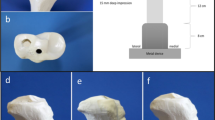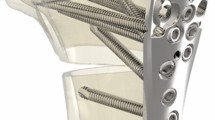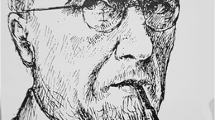Summary
The load axis of the curved proximal femur lies not inside but outside the bone. Therefore, high bending forces are acting, the medial cortex absorbing pressure and the lateral cortex absorbs tension. In a transverse fracture, a laterally applied plate will absorb the tensile stresses and the medial cortex, the pressure forces. When the medial buttress due to a bony defect is missing, the laterally applied plate is subjected to cyclic bending and will undergo fatigue fracture. This dilemma is compensated by a wave plate with bone graft: the compression forces are redirected to the lateral cortex, and the plate is again subjected to tension. Furthermore, since the plate stands away from the bone, it does not disturb the blood supply at the fracture site and thus bone healing.
Similar content being viewed by others
References
Beam HP Jr, Seligson D (1980) Nine cases of bilateral femoral shaft fractures: a composite view. J Trauma 20:399–402
Breederveld RS, Patka P, van-Mourik JC (1985) Refractures of the femoral shaft. Neth J Surg 37:114–116
Convent L (1977) On secondary fractures after removal of internal fixation material. Acta Orthop Belg 43:89–93
Frankel VH, Burstein AH (1968) The biomechanics of refracture of bone. Clin Orthop 60:221–225
Katzner M, Petit R, Schvingt E (1975) Osteosynthese des fractures trochantero-diaphysaires et sous-trochanteriennes (à propos de 57 osteosyntheses). J Chir (Paris) 109:53–62
Loomer RL, Meek R, De-Sommer F (1980) Plating of femoral shaft fractures: the Vancouver experience. J Trauma 20:1038–1042
Lüscher JN, Ruedi T, Allgöwer M (1978) Erfahrungen mit der Plattenosteosynthese bei 131 Femurschaft-Trümmerfrakturen. Helv Chir Acta 45:39–42
Müller KH, Witzel U (1984) Die Brückenplatte zur Osteosynthese bei ossären Schaftdefekten des Femur als eine Konsequenz nach Fehlschlagen von Plattenosteosynthesen. Unfallheilkunde 87:237–246
Pauwels F (1965) Gesammelte Abhandlungen zur funktionellen Anatomie des Bewegungsapparates. Springer, Berlin Heidelberg New York
Pauwels F (1973) Atlas zur Biomechanik der gesunden and kranken Hüfte. Springer, Berlin Heidelberg New York
Roberts JB (1977) Management of fractures and fracture complications of femoral shaft using the ASIF compression plate. J Trauma 17:20–28
Teubner E, Fischer H (1980) Die operative Behandlung instabiler per- und subtrochanterer Oberschenkelfrakturen mit der 130 Grad T-Platte. Chirurg 51:685–692
Thompson F, O-Breine J, Gallagher J, Sheehan J, Quinlan W (1985) Fractures of the femoral shaft treated by plating. Injury 16:535–538
Wardlaw D (1977) The cast-brace treatment of femoral shaft fractures. J Bone Joint Surg [Br] 59:411–416
Weber BG, Brunner C (1982) Special techniques in internal fixation. Springer, Berlin Heidelberg New York
Author information
Authors and Affiliations
Rights and permissions
About this article
Cite this article
Blatter, G., Weber, B.G. Wave plate osteosynthesis as a salvage procedure. Arch Orthop Trauma Surg 109, 330–333 (1990). https://doi.org/10.1007/BF00636171
Issue Date:
DOI: https://doi.org/10.1007/BF00636171




